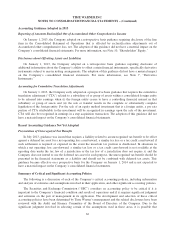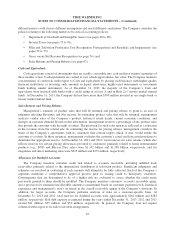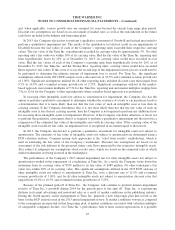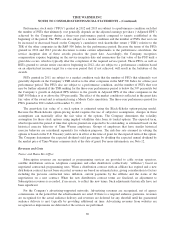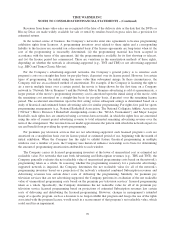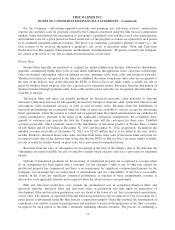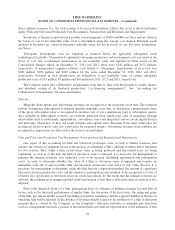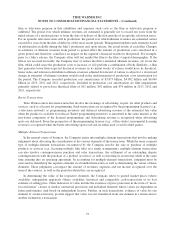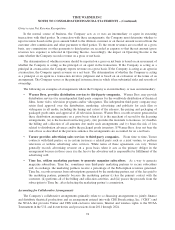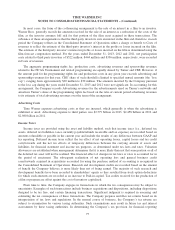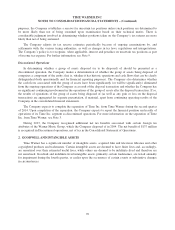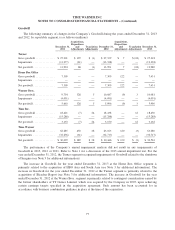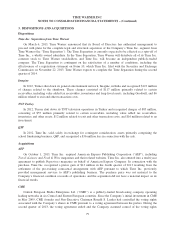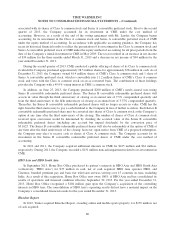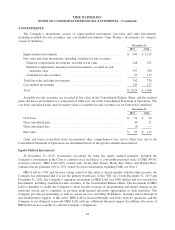Time Magazine 2013 Annual Report Download - page 88
Download and view the complete annual report
Please find page 88 of the 2013 Time Magazine annual report below. You can navigate through the pages in the report by either clicking on the pages listed below, or by using the keyword search tool below to find specific information within the annual report.TIME WARNER INC.
NOTES TO CONSOLIDATED FINANCIAL STATEMENTS – (Continued)
film’s ultimate revenues (i.e., the total revenue to be received throughout a film’s life cycle) is discussed further
under “Film and Television Production Cost Recognition, Participations and Residuals and Impairments.”
Inventories of theatrical and television product consist primarily of DVDs and Blu-ray Discs and are stated at
the lower of cost or net realizable value. Cost is determined using the average cost method. Returned goods
included in Inventory are valued at estimated realizable value, but not in excess of cost. For more information,
see Note 6.
Videogame development costs are expensed as incurred before the applicable videogames reach
technological feasibility. Unamortized capitalized videogame production and development costs are stated at the
lower of cost, less accumulated amortization, or net realizable value and reported in Other assets on the
Consolidated Balance Sheet. At December 31, 2013 and 2012, there were $243 million and $173 million,
respectively, of unamortized computer software costs related to videogames. Amortization of such costs was
$180 million, $182 million and $163 million for the years ended December 31, 2013, 2012 and 2011,
respectively. Included in such amortization are writedowns to net realizable value of certain videogame
production costs of $53 million, $7 million and $16 million in 2013, 2012 and 2011, respectively.
The Company enters into collaborative arrangements from time to time with third parties to jointly finance
and distribute certain of its theatrical productions (“co-financing arrangements”). See “Accounting for
Collaborative Arrangements” for more information.
Time Inc.
Magazine Subscription and Advertising revenues are recognized at the magazine cover date. The unearned
portion of magazine subscriptions is deferred until the magazine cover date, at which time a proportionate share
of the gross subscription price is recognized in revenues, net of any commissions paid to subscription agents.
Also included in Subscription revenues are revenues generated from single-copy sales of magazines through
retail outlets such as newsstands, supermarkets, convenience stores and drugstores and on certain digital devices
and platforms, which may or may not result in future subscription sales. Revenues from retail outlet sales are
recognized based on gross sales less a provision for estimated returns. Advertising revenues from websites are
recognized as impressions are delivered or the services are performed.
Film and Television Production Cost Recognition, Participations and Residuals and Impairments
One aspect of the accounting for film and television production costs, as well as related revenues, that
requires the exercise of judgment relates to the process of estimating a film’s ultimate revenues and is important
for two reasons. First, while a film or television series is being produced and the related costs are being
capitalized, as well as at the time the film or television series is released, it is necessary for management to
estimate the ultimate revenues, less additional costs to be incurred (including exploitation and participation
costs), in order to determine whether the value of a film or television series is impaired and requires an
immediate write-off of unrecoverable film and television production costs down to fair value. Second, it is
necessary for management to determine, using the film forecast computation method, the amount of capitalized
film and television production costs and the amount of participations and residuals to be recognized as Costs of
revenues for a given film or television series in a particular period. To the extent that the ultimate revenues are
adjusted, the resulting gross margin reported on the exploitation of that film or television series in a period is also
adjusted.
Prior to the theatrical release of a film, management bases its estimates of ultimate revenues for each film on
factors such as the historical performance of similar films, the star power of the lead actors, the rating and genre
of the film, pre-release market research (including test market screenings) and the expected number of theaters in
which the film will be released. In the absence of revenues directly related to the exhibition of a film or television
program that is owned by the Company on the Company’s television networks or premium pay television
services, management estimates a portion of the unamortized costs that are representative of the utilization of that
72


